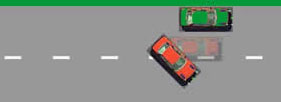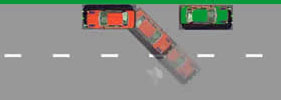Manoeuvres Reverse Parallel Parking
Introduction
This manoeuvre requires that you are able to reverse your vehicle into a space, not exceeding two car lengths, between two cars at the kerbside.
This makes use of the vehicle's manoeuvrability to park in a restricted space.
It is easier to reverse into a tight space than to drive straight in. You can reverse into a space of about 1 1/2 vehicle lengths while driving in may take as much as 4 vehicle lengths.
Your examiner should ask you to pull in on the left several car lengths before a target vehicle.
They will then explain what is required. On the test you will only have to reverse behind the target vehicle with no secondary vehicle. This will reduce the pressure on you considerably.
Three key skills are required to successfully carry out the parallel parking manoeuvre:
- Control: Keep under a slow, controlled speed using clutch control
- Accuracy: Park close to, and parallel with, the kerb
- Observation: Be aware of everything around you and to act accordingly

Stage One Choose Your Spot
After taking good all-round observation you should pull alongside the target vehicle and position your car so that you can safely carry out the exercise.
You should use the MSM routine and position reasonably close, (no more than a door's width away), and parallel to the parked vehicle. A good reference is if you pull slightly ahead of the vehicle so that YOU are level with the front bumper of the target.
Stop, apply your handbrake and select reverse immediately. This lets anyone approaching from behind know what you are intending.

Stage Two Reverse To Point-Of-Turn
Take good observations and reverse slowly back to your point-of-turn.
This should be when your rear wheel is about level with the rear of the target, you can judge this by lining up your back seat with the back bumper. This is an important reference as your rear wheel is where your vehicle will pivot around the parked vehicle.
Pause to take further observations before turning. The front of your car will swing out into the road so make sure you check for approaching vehicles.

Stage Three Reversing
When safe, start to reverse turning your steering wheel just one complete turn to the left.
You should allow your car to come around to a 45 degree angle before turning one turn back to the right to straighten your wheels.
You can now reverse back into the rest of the gap.

Stage Four Approaching The Kerb
You should judge when the rear,nearside wheel of your car is about a foot and a half from the kerb and then turn your steering wheel one turn to the right to begin bringing the front of your car into the space toward the kerb.

Stage Five Finishing Off
Watch in your side mirror for the nearside of your vehicle to come parallel with the kerb and then turn your steering wheel one turn back to the left to straighten your wheels. Allow your car to come far enough back to leave sufficient room for you to pull out again.
You should take good, all-round observation throughout the exercise. You should reverse your car slowly, smoothly and under full control making good use of the accelerator, clutch, braking and steering. You should ensure that when bringing the front of the vehicle around that you have sufficient clearance from the target vehicle.
You should not mount or touch the kerb or the target vehicle. You should not take more than a reasonable time, creating a hazard for other road users. Try not to steer while the car is stationary (dry steering), you will not fail your test for this but it is not good driving practice.

